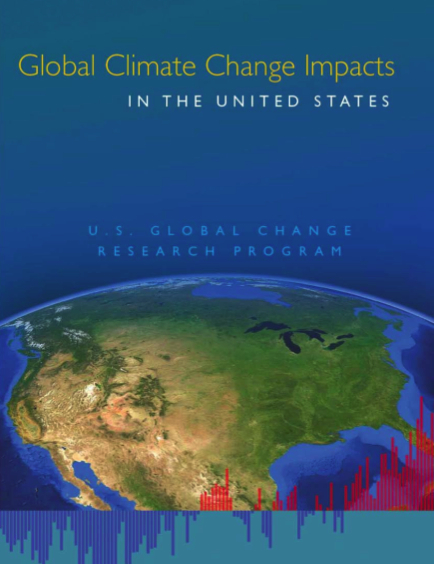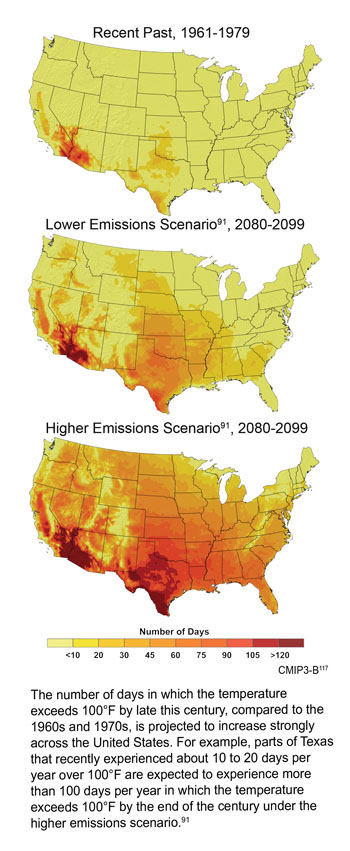By Bill Dawson
 With much of Texas enduring a late-spring spell of high temperatures, the last thing many Texans probably want to hear right now is that their hot state could very well get a lot hotter.
With much of Texas enduring a late-spring spell of high temperatures, the last thing many Texans probably want to hear right now is that their hot state could very well get a lot hotter.
That scenario, however, is one of the key projections in a new federal report, “Global Climate Change Impacts in the United States,” issued Monday in Washington.
With higher emissions of greenhouse gases, a large part of Texas could see more than 100 days a year with highs above 100 degrees by 2100, it said.
As manmade global warming progresses in coming decades, other impacts in prospect for Texas include greater stresses on water resources and damaging effects from sea-level rise, according to the report, which was launched in the George W. Bush administration in 2007 by 13 agencies working through the U.S. Global Change Research Program.
The 190-page document is the first major federal appraisal of region-by-region impacts of climate change in the U.S. since 2000. It incorporates scientific findings that were peer-reviewed and being prepared for publication as recently as last December.
Rising temperatures, water worries, higher sea level – all of these and additional effects of climate change have been projected for Texas in previous reports by various experts. [One such assessment is The Impact of Global Warming on Texas, commissioned by the Houston Advanced Research Center, publisher of Texas Climate News. The book was posted online in January and will be published by University of Texas Press.]

Katharine Hayhoe
Katharine Hayhoe, a research associate professor in Texas Tech University’s Geoscience Department and a member of the new federal report’s 28-member team of authors, acknowledged that certain conclusions will seem familiar to some readers and said the new report is not meant to replace those earlier assessments.
But Hayhoe, lead author of the report’s chapter on the Great Plains region, which includes most of Texas, stressed its value in portraying the current state of scientific knowledge about how climate change is already impacting the different regions of the country and will do so in the future.
“This is the most comprehensive and up-to-date picture of how climate change will affect every region,” she said in an interview with Texas Climate News, shortly after the federal report’s release.
The report incorporates studies for various regions, economic sectors and industries and “pulls them together into one picture,” she said. “It shows how widespread climate change’s impacts are, how it’s affecting all of our lives in many ways we didn’t picture before. That’s the most powerful aspect of the report – we’re already being affected.”
A key message in the report for Texans is that the state’s natural resources are already under pressure from climate change, which will exacerbate stresses on features including Panhandle wetland areas known as playa lakes, grasslands, water resources and coastal areas in the future, she said.
There is no chapter in the report solely on Texas, but the following passages mentioning the state were gleaned from different places in the document. (The reference in the first passage to a “higher emissions scenario” pertains to the authors’ use of different future levels of emissions of greenhouse gases in making projections. They included this disclaimer: “None of the emissions scenarios used in this report assume any policies specifically designed to address climate change. All, including the lower emissions scenario, assume increases in heat-trapping gas emissions for at least the next few decades, though at different rates.”)
- “The number of days in which the temperature exceeds 100°F by late this century, compared to the 1960s and 1970s, is projected to increase strongly across the United States. For example, parts of Texas that recently experienced about 10 to 20 days per year over 100°F are expected to experience more than 100 days per year in which the temperature exceeds 100°F by the end of the century under the higher emissions scenario.”
- “Regional variations in relative sea-level rise are expected in the future. For example, assuming historical geological forces continue, a 2-foot rise in global sea level (which is within the range of recent estimates) by the end of this century would result in a relative sea-level rise of 2.3 feet at New York City, 2.9 feet at Hampton Roads, Virginia, 3.5 feet at Galveston, Texas, and 1 foot at Neah Bay in Washington state.”
- “There is a high likelihood that water shortages will limit power plant electricity production in many regions. Future water constraints on electricity production in thermal power plants are projected for Arizona, Utah, Texas, Louisiana, Georgia, Alabama, Florida, California, Oregon, and Washington state by 2025.”
- “More frequent interruptions in air service and airport closures can be expected. Airport facilities including terminals, navigational equipment, perimeter fencing, and signs are likely to sustain increased wind damage. Airports are frequently located in low-lying areas and can be expected to flood with more intense storms. As a response to this vulnerability, some airports, such as LaGuardia in New York City, are already protected by levees. Eight airports in the Gulf Coast region of Louisiana and Texas are located in historical 100-year flood plains; the 100-year flood events will be more frequent in the future, creating the likelihood of serious costs and disruption.”
A more comprehensive idea of the report’s conclusions relevant to Texas comes from the “key issues” listed for each of the three national regions including parts of the state. A narrow area along the coast and stretching northward along the state’s borders with Louisiana and Arkansas was included in the report’s Southeast region. Most of the state was included in the Great Plains region. The westernmost tip of the state, including El Paso and the Big Bend country, was considered as part of the Southwest region. The authors’ “key issues” for the three regions:
Southeast
- “Projected increases in air and water temperatures will cause heat-related stresses for people, plants, and animals.”
- “Decreased water availability is very likely to affect the region’s economy as well as its natural systems.”
- “Sea-level rise and the likely increase in hurricane intensity and associated storm surge will be among the most serious consequences of climate change.”
- “Ecological thresholds are likely to be crossed throughout the region, causing major disruptions to ecosystems and to the benefits they provide to people.”
- “Quality of life will be affected by increasing heat stress, water scarcity, severe weather events, and reduced availability of insurance for at-risk properties.”
Great Plains
- “Projected increases in temperature, evaporation, and drought frequency add to concerns about the region’s declining water resources.”
- “Agriculture, ranching, and natural lands, already under pressure due to an increasingly limited water supply, are very likely to also be stressed by rising temperatures.”
- “Climate change is likely to affect native plant and animal species by altering key habitats such as the wetland ecosystems known as prairie potholes or playa lakes.”
- “Ongoing shifts in the region’s population from rural areas to urban centers will interact with a changing climate, resulting in a variety of consequences.”
Southwest
- “Water supplies will become increasingly scarce, calling for trade-offs among competing uses, and potentially leading to conflict.”
- “Increasing temperature, drought, wildfire, and invasive species will accelerate transformation of the landscape.”
- “Increased frequency and altered timing of flooding will increase risks to people, ecosystems, and infrastructure.”
- “Unique tourism and recreation opportunities are likely to suffer.”
- “Cities and agriculture face increasing risks from a changing climate.”
With the hotly contested Waxman-Markey bill to limit greenhouse emissions making its way through Congress, the report authors and Obama administration officials took pains to emphasize that work on the regional appraisal had begun during the Bush administration, that it represents a broad and thoroughly-vetted scientific consensus and that it does not include specific policy recommendations.
Still, the report included this cautionary note that clearly relates to the broader debate on the scope of emissions cuts that the nation (and world) should undertake:
“Implementing sizable and sustained reductions in carbon dioxide emissions as soon as possible would significantly reduce the pace and overall amount of climate change and would be more effective than reductions of the same size initiated later.”
And administration officials were just as clearly hoping that the report would help move public opinion toward greater support of for the kinds of emission reductions that President Barack Obama has called for.
The Wall Street Journal’s Keith Johnson reported these comments from Obama appointees upon the report’s release:
John Holdren, the presidential science advisor, was asked during the presentation of the paper if the report and its dire conclusions were meant to change votes, since the contentious Waxman-Markey bill faces plenty of sniping in Congress. Short answer – no, but yes:
“This report is not about a policy or a particular piece of legislation. It is about the science, and why we have to act sooner rather than later […] It is part of a larger process of public and policy-maker education, to help move ahead smartly after many years of dithering and delay.”
Jane Lubchenco, the head of the National Oceanic and Atmospheric Administration and another star player in Team Obama’s green lineup, cut to the chase: “Much of the foot-dragging on climate change is a reflection of the public’s perception,” she said, calling the new report a “game changer.”

Global Climate Change Impacts in the United States U.S. Global Change Research Program, 6/16/09
